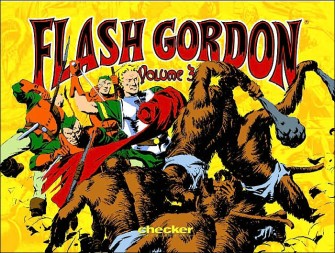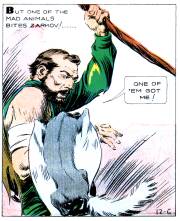
November 15, 2007
 CR Review: Flash Gordon, Vol. 3
CR Review: Flash Gordon, Vol. 3

 Creators:
Creators: Alex Raymond, Don Moore
Publishing Information: Checker, hard cover, 100 pages, March 2005, $19.95
Ordering Numbers: 9781933160252 (ISBN13)
I simply didn't have an ear for aural perfection. When my teenage-years friends were spending hundreds of dollars on audio equipment for their bedrooms and cars, I made do with a mess of inherited pieces and low-end machines. That's true of comics and print quality as well, as many frustrated cartoonists who have had to sit me down with print jobs I think have gone swell and point out to me where the register is off will attest. All of that is necessary prelude to making this point: I don't know if Checker Publishing's hardcovers of Alex Raymond's
Flash Gordon era are printed with a degree of exactitude to please all of the material's fans. It looks fine to me; not being familiar with 1930s newspaper hot off the press it looks close to what my father's paper might have done 40 years later. Given the older papers' reputation for color saturation and clearer printing, this makes me think that someone with a more exacting eye might find reason to complain about one thing or another here. Well, even if it's true, I can only appreciate their pain, not share in it. I thought they looked just fine.
That means I get to read the comics with an unburdened mind. Checker's formatting allows the volume room for four unfettered serials from 1936 to 1938. They are divided into two out-in-nature adventures and two more palace and political intrigue-type adventures. The first two adventures are a lot more crazy and fun in a way, more direct in terms of what's at stake and allowing Raymond to riff on a number of natural circumstances, ugly caveman types and a horde of wonderful monsters. It's hard to imagine the joy this strip must have been for kids who yearned for an out of this world experience before comic books, TV shows and films devoted to them became a part of the fabric of life. To see an artist of this quality drawing spaceships and creatures and a burly, athletic hero defeating everything in front of him by physical beat downs and force of will must have felt for a lot of kids that Raymond had made
Flash Gordon just for them. I bet most of those kids preferred the monster-heavy sequences. However, the final two chapters, for all their forced narration, seem to make for better comics. The plot points are less singular and relentless, the can-you-top-this energy of this volume's first half proves fairly exhausting.

There's a natural tension in Raymond's art in terms of how the reader's eye moves across the page in a way that builds narrative momentum and how it settles on one magnificent image after another in order to enjoy it on that level. Raymond's skilled at both, almost otherworldly so, but when you're in a run of new physical perils every week, that delicate balance tips towards backing away from the progression of the story and enjoying the monster of the week, both terrifying (a tree that chokes people to death in its vines) and occasionally ridiculous (flying, vicious, madness-inducing squirrels). That doesn't mean it stops being comics. I'm not one who automatically favors narrative propulsion over pictures that hold interest and one's attention, but the powerful mix between the two that distinguishes Raymond's best runs on the feature goes away when the strip favors action to the exclusion of everything else, that running in the forest away from creatures kind of physical activity.
I've never read a bunch of Raymond's
Flash Gordon in a row. I'm struck by how less wimpy than most of her peers Dale Arden tends to be, and I like the fact that we never get a real sense of Gordon's physical appearance. Like most people, he doesn't have one face but several, driven by the situation in which he finds himself. I also found fascinating the strip's underlying morality, which seems to go past things like fair play and a vow against cruelty and into a larger statement about how moral and physical virtue may be closely related, and how interacting with other cultures not only demands a cautious hand, it occasionally asks for one balled into a big jaw-cracking fist. My favorite sequence is one where Flash strips down into his tights and with only a knife in his hand takes on a tank and kicks its ass, eventually turning the tide of combat in his favor. That's a very potent image, and it's the visual punch of Raymond's artwork that suggests a bit more than simply a run of stripped-down adventures. It's a fascinating way to look at the world, and at the past, in these times when we're less likely to see societal implications in a sock to the jaw.
 posted 11:00 am PST
posted 11:00 am PST |
Permalink
Daily Blog Archives
November 2019
October 2019
September 2019
August 2019
July 2019
Full Archives


